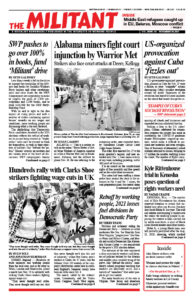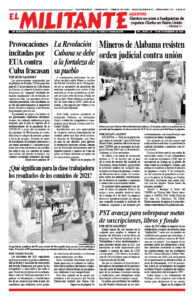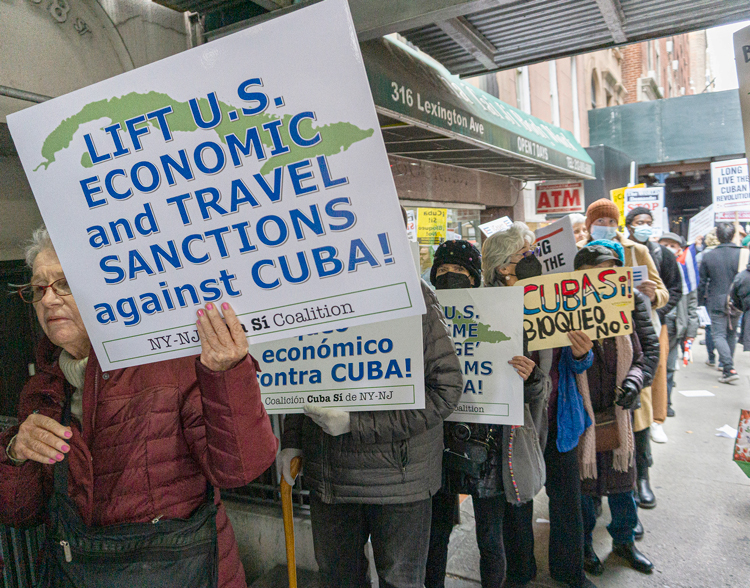U.S.-government-organized provocations planned in Cuba for Nov. 15 were a failure, as were “sympathy” actions denouncing Cuba’s socialist revolution around the world. Opponents of the revolution had hoped to create incidents on the island that would disrupt the reopening of schools and businesses and expanded tourism scheduled that day.
Striking a blow to the U.S. rulers’ plans, Cubans celebrated the tremendous progress the country has made in confronting the COVID-19 pandemic despite Washington’s stepped-up sanctions, which make it difficult to purchase raw materials and even syringes. Tens of thousands of elementary school students returned to classes, bringing to 1.7 million the number studying across the island. The number of flights carrying international tourists were tripled, with vaccinated travelers now admitted without quarantining.
As of Nov. 15, 78% of the population was fully vaccinated and 90% had received at least one shot of the highly effective vaccines designed and produced in Cuba. The number of deaths has dropped sharply to three or less per day.
This success is possible because working people in Cuba, led by Fidel Castro, overthrew the U.S.-backed dictatorship of Fulgencio Batista in 1959 and replaced capitalist rule with a workers and farmers government. The mobilization of mass organizations, youth and working people to make sure everyone in Cuba got the care they needed in the face of the pandemic is one more proof that the socialist revolution remains very much alive today.
Washington and small groups opposed to the revolution in Cuba had hoped they could organize a repeat of protests that took place in Cuba July 11, when they were able to attract some working people and youth who support the revolution but are frustrated over the country’s difficult economic situation.
For more than 60 years Washington has spent hundreds of millions to organize counterrevolutionary operations inside Cuba, with the aim of undermining and overthrowing the socialist revolution.
But the U.S. rulers underestimated — as they always do — the capacity of Cuban working people and their revolutionary government to stand up to the U.S. pressures.
Days before the so-called Civic March for Change, called by the U.S.-backed group Archipelago, its organizers admitted few would show up. Blaming “repression” in Cuba, they made a shift and called on their supporters to wear white, hang white sheets and bang pots and pans outside their windows, and “boycott” television news. Even longstanding opponents of the revolution — such as the New York Times — admitted that their actions had “fizzled.”
Government officials, including President Miguel Díaz-Canel, have been visiting neighborhoods and towns in Cuba where working people face the greatest difficulties in housing and government services. They have been speaking with working people there and organizing to work together to make progress in confronting the challenges they face.
A group of young people began a two-day “Red Bandana Sit-in” Nov. 14-15 at Havana’s Central Park to demonstrate their support for the revolution and as an answer to the U.S.-backed provocations. They camped out in tents and held book discussions, poetry readings and a concert in support of Cuba’s sovereignty that attracted several thousand people.
President Díaz-Canel joined them Nov. 14. “We are seeking to improve our society. We are defending emancipation, defending socialism and denouncing the campaigns to subvert our internal order, the media campaigns against Cuba — just as you are in your action,” he told participants there.
Luis Emilio Aybar, a member of the Saíz Brothers Association, an organization of young artists and writers, told the press that their convictions “include revolutionary criticism. But in the fight for rights, there is no room for terrorists, for imperialists or those who support the U.S. blockade of Cuba.”
Supporters of Washington’s efforts to overturn the revolution organized protests in a number of cities around the world. None were very large.
In New York City the Cuba Sí Coalition brought together 150 opponents of the U.S. embargo Nov. 15, substantially outnumbering a group of counterrevolutionary protesters across from the Cuban U.N. Mission.
The action in solidarity with the Cuban Revolution included Puerto Rico groups that back independence for the U.S. colony, Dominican organizations, Cuban Americans, Haitian activists and members of several other political groups, including the Socialist Workers Party, Party for Socialism and Liberation, Young Communist League, Workers World Party, and Democratic Socialists of America.
Univisión, the Spanish-language TV network, sent reporters who interviewed participants from the two competing protests. But their news broadcast reported only on the small counterrevolutionary action, never showing on TV or even mentioning the much larger protest against the embargo and the U.S.-organized provocations.
Similar counterposed actions took place in several other U.S. cities and around the world. In Buenos Aires, Argentina, a coalition of pro-Cuban Revolution unionists and political activists brought out 1,000 people in front of the Cuban Embassy.
In London, about 150 people, chanting “Hands off Cuba — End the Blockade,” rallied outside the Cuban Embassy Nov. 14, in response to calls by the Cuba Solidarity Campaign, Cubans in the U.K., Rock Around the Blockade, the Communist League and others. They far outnumbered a small protest in favor of the U.S. embargo.


